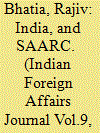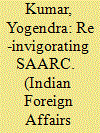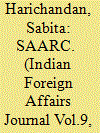|
|
|
Sort Order |
|
|
|
Items / Page
|
|
|
|
|
|
|
| Srl | Item |
| 1 |
ID:
137127


|
|
|
|
|
| Summary/Abstract |
As the EAS completes ten years of its existence this year, India expects to enter into a more holistic cooperation with the EAS. Apart from economic ties, greater cooperation on the challenges of human resource development, renewable energy, transportation infrastructure, public health and scientific research are some of the potential but crucial areas where greater efforts from the stakeholders and respective governments are required. For India, it may also imply that it needs to act fast and in a comprehensive way, if it wishes to engage in the EAS forum to use it as a part of a wider platform to cause a paradigm shift towards “Act East” from its usual “Look East.”
|
|
|
|
|
|
|
|
|
|
|
|
|
|
|
|
| 2 |
ID:
137119


|
|
|
|
|
| Summary/Abstract |
South Asia’s environment, both internally and externally, has been changing rapidly. The growing Chinese presence in South Asia can be seen both positively as ‘a benign extension of influence’. Or negatively as ‘ingress’ with ‘a larger strategic purpose’. However, the important point is that it cannot be ignored. Nor can it be addressed with the mindset of yesterday. A judicious blend of resilience and the steady accretion of internal strength seem to be the best pathway for India.
|
|
|
|
|
|
|
|
|
|
|
|
|
|
|
|
| 3 |
ID:
137125


|
|
|
|
|
| Summary/Abstract |
The changing geopolitics of energy in favour of Asian countries, the crucial dependence of the latter on West Asia for their energy security, and the interest of the USA in sharing the responsibility for regional security, these developments have thrown up new opportunities for Asian countries to pursue shared interests that would bring the USA, other Western powers, and the principal Asian powersChina, Japan, Korea and Indiain a new cooperative paradigm structured around the GCC countries, Iran and Iraq.
The challenges in realizing this strategic paradigm would require the principal regional players to give up their present postures of confrontation and hostility, and engage with erstwhile rivals on the same platform for dialogue, the establishment of confidence building measures, and the addressing of issues that divide them in a free and frank environment.
Before this happens, the four principal Asian countries would themselves have to develop the habit of dialogue as well as the development of consensus amongst themselvesa daunting task in itself since Asian countries have little experience of strategic dialogue with each other on Asian issues.
|
|
|
|
|
|
|
|
|
|
|
|
|
|
|
|
| 4 |
ID:
137123


|
|
|
|
|
| Summary/Abstract |
What of the future? Most importantly, unless Pakistan changes course radically towards India, SAARC as SAARC will essentially limp along. Even if India takes initiatives in the interests of the region, Pakistan will stymie them as it will not want India’s ‘hegemony’ to be consolidated. Pakistan’s attitude will not change unless it’s internal polity changes. This is not likely to happen given the dynamics inside Pakistan and the broader Islamic region with which it associates itself.
At the Kathmandu summit, India warned that regional integration will proceed with all, or without some, which suggests that if Pakistan does not cooperate, others can go ahead without it. If that happens, it will mean, of course, the emasculation of the idea of SAARC. However, Pakistan will not be easily isolated, as most other SAARC countries will seek to keep it involved in order to balance India’s weight. Side-tracking Pakistan will also mean that the integration of Afghanistan into SAARC will become practically impossible. BIMSTEC, which groups all SAARC countries except Pakistan and Maldives, provides an option for regional cooperation for India and others, with the added advantage of providing a seamless link to Southeast Asia through Myanmar and Thailand, the other two members of BIMSTEC. The SAARC charter does provide for sub-regional cooperation, but with the concurrence of the rest. This makes Pakistan’s role a major road block.
|
|
|
|
|
|
|
|
|
|
|
|
|
|
|
|
| 5 |
ID:
137121


|
|
|
|
|
| Summary/Abstract |
SAARC has not really realised its full potential because conditions do not exist in the neighbourhood for economic cooperation. Bilateral disputes plague the association and, without mutual trust, no regional organisation can function effectively. India has gained more by its association with the ASEAN rather than with SAARC. Even the declarations of SAARC are rarely implemented
Prime Minister Narendra Modi’s vision of SAARC becoming a corner stone of India’s foreign policy has already suffered a setback. Pakistan raised bilateral issues on the floor of the United Nations even in September 2014, thus violating the spirit of bilateralism and regional cooperation. Other states in the region are also not ready yet to work in a spirit of cooperation. In the meantime, SAARC can operate only on the basis of the lowest common denominators among its members. India would continue to improve its relations with each of its neighbours so that SAARC could become a true regional organisation like the European Union or the ASEAN. In the current situation in the Asia Pacific, characterised by rivalry between the US and China, such a transformation may be hard to accomplish.
|
|
|
|
|
|
|
|
|
|
|
|
|
|
|
|
| 6 |
ID:
137120


|
|
|
|
|
| Summary/Abstract |
It is now universally recognised that the regional cooperation in South Asia is far less developed in comparison to other regions. There is irony in this situation, as countries in the region have very strong historical and civilisational links even as they occupy the same economic space. These regional commonalities were sought to be fleshed out through the establishment of the South Asian Association for Regional Cooperation (SAARC) in December 1985. It was expected that these commonalities would provide a strong enough basis for significant regional integrationas, indeed, it was before 1947and for socio-economic progress, thereby strengthening regional political stability by keeping the negative tendencieslike backwardness, obscurantism and extremismat bay.
Yet, the sad reality is that other regional organisations, such as the European Union and the ASEANcomprising an even more diverse group of countrieshave been far more successful than SAARC. Indeed, the latter could, perhaps, be less favourably compared even with more recent organisations such as the African Union or the ECO. As an organisation, SAARC has underperformed throughout its history, and the level of regional integration is woefully short of its promise. Even its summits are becoming irregular. Perhaps, the unsatisfactory level of regional integration can partly be considered as a contributory factor in the prevailing situation where the region represents a microcosm of the range of security threats being faced by the world at large. This reality appears even more distressing, given the considerable ongoing movement of peoples in South Asia across borders, and the phenomenon of very easy social relationships overseas amongst members of the respective Diasaporas..
|
|
|
|
|
|
|
|
|
|
|
|
|
|
|
|
| 7 |
ID:
137118


|
|
|
|
|
| Summary/Abstract |
The business-as-usual option forces member states and the secretariat to, willy-nilly, reduce the entire regional exercise to a talk shop of many levels, the summit being the topmost. At the same time, it is difficult to abandon this framework since no country would take the blame for doing it. While there are a number of other regional and sub-regional options actively considered and debated in think tanks and academia, the brute fact is that their praxis may not differ much from that of SAARC. This is because it is the same ministries and personnel in the capitals who deal with even the new formats, and mostly the same ideas and initiatives resurface. Take, for example, BIMSTEC. In the past several years, even BIMSTEC has fallen in a similar groove of a well trodden economic agenda, trade and infrastructure, investment, banking, etc., and similarly, a fledgling secretariat fumbling for staff and resources, and not much to show. The Indian Ocean Rim outfit has even larger membership, but similar handicaps.
It is, therefore, unrealistic to see alternatives to SAARC emerge successfully unless very high level interest is taken in a continuous process which begins with a doable and less ambitious agenda hooked to the quick delivery of results. In this sense, there is no doubt that bilateral cooperative processes move faster; but, should that put an end to regionalism?
|
|
|
|
|
|
|
|
|
|
|
|
|
|
|
|
| 8 |
ID:
137124


|
|
|
|
|
| Summary/Abstract |
SAARC is not a forum for clearing Indo-Pak distrust; it stands for far greater regional interests. No country should be allowed to be a spoiler of this serious agenda. Being the two most important members of the regional association, both India and Pakistan shoulder a special responsibility to instil new life and vigour in regional cooperation and go beyond paying lip service to it. Subramanian Swamy, the Chairman of the Bharatiya Janata Party’s Strategic Affairs Committee, commented in The Hindu on 25 November 2014, “Since India constitutes 70 per cent or more of SAARC’s area and population, and has political conflicts with all its neighbours, India has to redefine its role, from seeking reciprocity in bilateral relations, to being prepared to go the extra mile in meeting the aspirations of all other SAARC nations.”. The greater regional interests should not be sacrificed at the altar of the intransigent attitudes of some member nations of SAARC.
|
|
|
|
|
|
|
|
|
|
|
|
|
|
|
|
| 9 |
ID:
137122


|
|
|
|
|
| Summary/Abstract |
Economic cooperation and integration became a part of the SAARC work agenda when the council of ministers of the member countries signed an agreement to form the South Asian Preferential Trade Agreement (SAPTA) in April 1993. The move was prompted by a desire of the South Asian economies to dismantle trade barriers following unilateral trade liberalisation as part of the systemic economic reforms initiated, first, in India, and later undertaken by other economies of the region. The economic reforms set the tone for both, a greater global integration of the South Asian economies as also increased growth momentum in the region. In the subsequent two decades, South Asia experienced high growth averaging over 5 per cent annually accompanied by a rapid pace of trade integration with the global economy. The rate of global trade integration of South Asia was the fastest among all regions in the world between 2005 and 2007.
The Indian economy emerged as the second fastest growing economy in the world. The economic dynamism and rapid global trade integration did not, however, translate into a higher level of economic integration among the South Asian economies; and intra regional trade remained at a low of around 5 per cent of the region’s total trade. The region, endowed with geographical, historical, cultural and linguistic proximity- all parameters that make the member economies the most natural trading partners, is today the least integrated region in the world. The process of economic integration in South Asia is marked by many contradictions. These are discussed below followed by the compelling regional and global imperatives to accelerate the pace of economic integration in South Asia. Finally, sub regionalism is presented as a possible way forward for regional cooperation in South Asia.
|
|
|
|
|
|
|
|
|
|
|
|
|
|
|
|
| 10 |
ID:
137126


|
|
|
|
|
| Summary/Abstract |
Production of shale oil and gas had begun in North America around 2007; however, its full impact began to be felt only around 2011. Its advent has been likened to that of the sighting of a ‘Black Swan’, an event that is rare, unusual and unexpected, and which is transformational of the ways in which the world lives and believes. Understandably, therefore, it has come to be described as a ‘revolution’. Nearly every one concurs that the shale revolution is to here stay. This essay examines two major issues associated with the shale revolution which bear scholarly significance: (i) its meaning in terms of global energy security, and the structural change that this revolution is bringing about in the global balance of power, the prospects of economic development, and climate change negotiations; and (ii) its impact and implications for India’s energy security, besides whatever else it may hold in terms of geo-political and economic opportunities
|
|
|
|
|
|
|
|
|
|
|
|
|
|
|
|
|
|
|
|
|